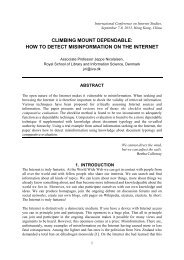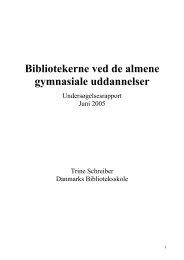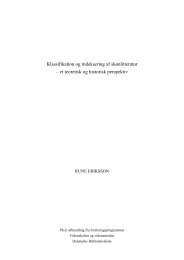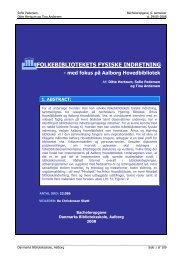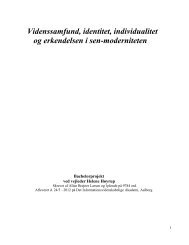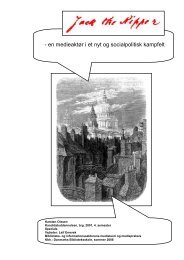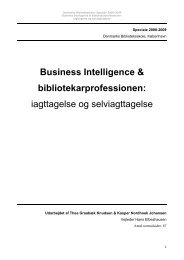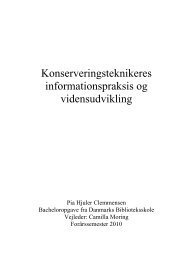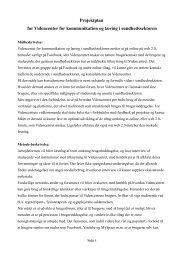Hvorfor er det sjovt at surfe på nettet? - Forskning
Hvorfor er det sjovt at surfe på nettet? - Forskning
Hvorfor er det sjovt at surfe på nettet? - Forskning
You also want an ePaper? Increase the reach of your titles
YUMPU automatically turns print PDFs into web optimized ePapers that Google loves.
v<strong>er</strong>ific<strong>er</strong>et d. 23/06/2011).<br />
80<br />
Und<strong>er</strong>holdende int<strong>er</strong>netsøgning<strong>er</strong> – S<strong>er</strong>ena Borsello<br />
K<strong>at</strong>z, E. & Foulkes, D. (1962). On the use of mass media as ”escape”: Clarific<strong>at</strong>ion of a<br />
concept. Public Opinion Qu<strong>at</strong><strong>er</strong>ly, 26(3), 377‐388.<br />
Kelly, D. (2009). Methods for evalu<strong>at</strong>ing int<strong>er</strong>active inform<strong>at</strong>ion retrieval systems with<br />
us<strong>er</strong>s. Found<strong>at</strong>ion and Trends in Inform<strong>at</strong>ion Retrieval, 3(1‐2), 1‐224.<br />
Kim, D. & Johnson, T.J. [in press] Political blog read<strong>er</strong>s: Predictors of motiv<strong>at</strong>ions for<br />
accessing political blogs. Telem<strong>at</strong>ic and Inform<strong>at</strong>ics.<br />
Kim, J. (2008). Task as a context of inform<strong>at</strong>ion seeking: An investig<strong>at</strong>ion of daily life tasks<br />
on the Web. Libri, 58, 172‐181.<br />
Kim, S. & Eastin, M. (2011). Hedonic tendencies and the online consum<strong>er</strong>: An investig<strong>at</strong>ion<br />
of the online shopping process. Journal of Int<strong>er</strong>net Comm<strong>er</strong>ce, 10(1), 68‐90.<br />
Kim, Y., Sohn, D. & Choi, S. M. (2011). Cultural diff<strong>er</strong>ence in motiv<strong>at</strong>ion for using social<br />
network sites: A compar<strong>at</strong>ive study of Am<strong>er</strong>ican and Korean college students.<br />
Comput<strong>er</strong>s in Human Behavior, 27, 365‐372<br />
Klimmt, C., Blake, C., Hefn<strong>er</strong>, D., Vord<strong>er</strong><strong>er</strong>, P. & Roth, C.(2009). Play<strong>er</strong> p<strong>er</strong>formance,<br />
s<strong>at</strong>isfaction, and video game enjoyment. ICEC Lecture Notes in Comput<strong>er</strong> Science<br />
5709, 1‐12.<br />
Knobloch‐West<strong>er</strong>wick, S. (2007). Gend<strong>er</strong> diff<strong>er</strong>ences in selective media use for mood<br />
management and mood adjustment, Journal of Broadcasting & Electronic Media,<br />
51(1), 73‐92.<br />
Knobloch‐West<strong>er</strong>wick, S., Hastall, M.R. & Rossmann, M. (2009). Coping or Escaping?:<br />
Effects of life diss<strong>at</strong>isfaction on selective exposure. Communic<strong>at</strong>ion Research,<br />
36(2), 207‐228.<br />
Kuhlthau, C.C. (1991). Inside the search process: Inform<strong>at</strong>ion seeking from the us<strong>er</strong>’s<br />
p<strong>er</strong>spective, Journal of the Am<strong>er</strong>ican Society for Inform<strong>at</strong>ion Science, 42(5), 361‐<br />
371.<br />
Laplante, A. & Downie, J.S. (2011). The utilitarian and hedonic outcomes of music<br />
inform<strong>at</strong>ion‐seeking in ev<strong>er</strong>yday life. Library & Inform<strong>at</strong>ion Science Research,<br />
33(3), 202‐210.<br />
Large, A., Beheshti, J. & Rahman, T. (2002). Design crit<strong>er</strong>ia for children´ s web portals: The<br />
us<strong>er</strong>s speak out. Journal of the Am<strong>er</strong>ican Society for Inform<strong>at</strong>ion Science and<br />
Technology, 53(2), 79‐94.<br />
L<strong>at</strong>orre, J.I. & Soto‐Sanfiel, M.T. (2011). Toward a theory of intellectual ent<strong>er</strong>tainment.<br />
Journal of Media Psychology, 23(1), 52‐59.<br />
Law, E.L‐C., Roto, V., Hassenzahl, M., V<strong>er</strong>me<strong>er</strong>en, A.P.O.S. & Kort, J. (2009). Und<strong>er</strong>standing,<br />
scoping and defining us<strong>er</strong> eXp<strong>er</strong>ience: A survey approach. CHI ´09, Proceedings<br />
of the 27th int<strong>er</strong>n<strong>at</strong>ion conf<strong>er</strong>ence on Human factors in computing systems, 719‐<br />
728.<br />
Lee, S. (1999). Priv<strong>at</strong>e uses in public spaces. A study of an int<strong>er</strong>net café. New Media &<br />
Society, 1(3), 331‐350.



